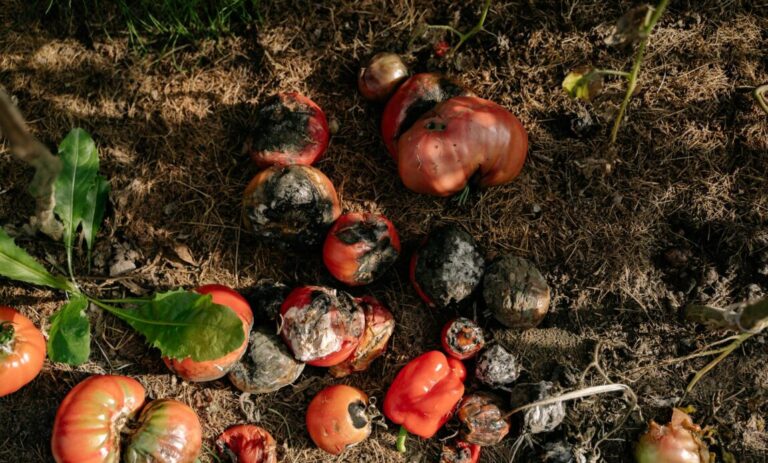Email: blogagri2@gmail.com
Top 10 Most Profitable Small Farm Crops to Grow

Are you ready to turn your green thumb into a golden opportunity? As the world shifts towards sustainable living and local sourcing, small farms are becoming powerful players in the agricultural landscape. Whether you’re dreaming of starting your own farm or looking to diversify your existing crops, 2024 is set to be an exciting year for profitable farming ventures! In this blog post, we’ll unveil the top 10 most lucrative crops that can thrive on small farms and help you tap into emerging trends. From unique heirloom vegetables to trendy superfoods, these crops not only promise impressive returns but also align with consumer demands for freshness and sustainability. So grab your gardening gloves and let’s dig into what it takes to cultivate success this coming year!
Introduction to small farm crops and the profitability of farming
Small farms are becoming a beacon of opportunity in today’s agricultural landscape. With the rise of sustainable practices and local food movements, many aspiring farmers are looking for ways to make their mark. But what if you could grow crops that not only thrive but also fill your pockets?
The profitability of small farm crops is more than just a dream; it’s an achievable reality. As consumer preferences shift towards organic, unique, and locally-sourced foods, certain crops stand out as golden opportunities waiting to be harvested.
Whether you have a sprawling plot of land or just a cozy backyard garden, finding the right crop can position you at the forefront of this lucrative industry. Let’s explore some key factors to consider when choosing profitable crops for your venture before diving into our list of top contenders for 2024!
Factors to consider when choosing profitable crops for your farm
Choosing the right crops for your farm requires careful thought. Start by assessing your local climate and soil conditions. Different plants thrive in various environments, so understanding what grows best in your area is crucial.
Next, consider market demand. Research trends to identify which crops are gaining popularity. High demand can lead to better pricing and higher profits.
Don’t forget about labor requirements. Some crops need more hands-on attention than others, impacting both time and costs.
Evaluate your resources too—water availability, tools, and land size all play a role in crop success.
Lastly, think about crop rotation practices that promote soil health while maximizing yield over seasons. Balancing these factors will pave the way for sustainable profitability on your small farm.
Top 10 most profitable small farm crops in 2024:
Avocados are soaring in popularity. Their creamy texture and health benefits make them a sought-after crop. With rising demand, they can yield impressive profits for small farmers.
Hemp is another lucrative choice. Its versatility ranges from textiles to oils, making it a hot commodity. The legal landscape continues to shift positively, increasing opportunities for growers.
Mushrooms are trending too. They require minimal space and can be cultivated year-round indoors or outdoors. Specialty varieties like shiitake or oyster command higher prices at markets.
Microgreens offer fast returns with their short growth cycle. Rich in nutrients and flavors, these tiny greens appeal to health-conscious consumers.
Garlic thrives in various soil types and has consistent market demand due to its culinary uses.
Medicinal herbs create niche markets that cater to wellness trends while requiring relatively low investment compared to traditional crops.
Edible flowers add beauty as well as flavor on plates; chefs love them!
Exotic fruits bring uniqueness but do require specific climates—think dragon fruit or lychee!
Olive oil production taps into gourmet food trends, especially if you grow your own olives.
Specialty grains and seeds focus on organic movement promises premium prices through unique offerings like heirloom varieties or gluten-free options.
- Avocados
Avocados have taken the culinary world by storm. Their creamy texture and versatility make them a favorite in salads, sandwiches, and smoothies. This fruit isn’t just trendy; it’s also incredibly profitable.
Growing avocados can yield substantial returns, especially if you target markets that embrace health-conscious eating. Demand continues to grow, particularly for organic varieties.
The climate is crucial for avocado cultivation. They thrive in warm conditions with well-drained soil. Farmers need to consider location carefully—California and Florida are prime spots in the U.S.
Investing in proper irrigation systems ensures healthy trees and bountiful harvests. With patience, an avocado tree can produce fruit for decades.
Farmers who engage directly with local restaurants or farmers’ markets often see higher profits than those relying solely on wholesalers. Social media marketing can further boost sales by highlighting unique recipes featuring this lush green gem.
- Hemp
Hemp is rapidly gaining attention as a highly profitable small farm crop. Its versatility sets it apart from many traditional crops. Farmers can cultivate hemp for seeds, fiber, or oil, tapping into multiple markets at once.
The hemp market has expanded significantly due to rising demand in industries such as textiles, health foods, and sustainable building materials. With the increasing popularity of CBD products derived from hemp flowers, farmers are finding lucrative opportunities.
Growing hemp requires specific conditions but offers rewarding returns if managed well. The plant thrives in various climates and soil types but flourishes with proper irrigation and care.
Furthermore, the low resource input needed makes it appealing for small-scale operations. As regulations around cannabis continue to ease globally, now may be an ideal time to consider adding this dynamic crop to your farming portfolio.
- Mushrooms
Mushrooms are an exciting crop for small farms. They require minimal space and can thrive indoors or outdoors. This versatility makes them perfect for various farming setups.
The demand for gourmet mushrooms like shiitake, oyster, and lion’s mane is rising. Chefs and home cooks alike seek fresh varieties to enhance their dishes. Their unique flavors add depth that many customers crave.
Growing mushrooms also has a quick turnaround time. Many species can be harvested within weeks of planting, offering rapid cash flow potential.
Using recycled materials like coffee grounds or straw as substrates creates an eco-friendly growing environment. This approach not only reduces waste but also attracts environmentally-conscious consumers.
As interest in health continues to grow, mushrooms are being recognized for their nutritional benefits too. Rich in vitamins and antioxidants, they appeal to a broad audience looking for healthy food options.
- Microgreens
Microgreens are tiny, nutrient-packed plants that have taken the culinary world by storm. These young seedlings can be harvested in just a few weeks, making them an attractive option for small farmers looking to turn a quick profit.
They require minimal space and resources. This allows you to maximize yield even on smaller plots of land. Their vibrant colors and intense flavors make them popular among chefs and health-conscious consumers alike.
Growing microgreens doesn’t demand extensive equipment or expensive inputs. A simple setup with trays, soil, and seeds is all you need to get started.
With their rising popularity in restaurants and grocery stores, microgreens present lucrative opportunities for local sales. Additionally, they can easily be marketed online or at farmer’s markets as gourmet ingredients or health foods.
- Garlic
Garlic is often overlooked, but it packs a punch as one of the most profitable crops for small farms. This versatile bulb thrives in various climates and can be grown year-round.
What makes garlic especially appealing is its high demand in both culinary and health markets. Chefs and home cooks alike love fresh garlic for its rich flavor, while health enthusiasts seek it out for its numerous benefits.
With minimal investment, you can cultivate different varieties—each with unique tastes and uses. Hardneck types are prized for their robust flavors, while softneck varieties store well.
Additionally, garlic has an impressive shelf life when harvested correctly. This quality allows farmers to sell throughout the year or capitalize on seasonal farmer’s markets.
Consider planting several plots with staggered harvests to maximize your yield during peak seasons. Garlic not only enriches dishes; it’s a smart choice for boosting your farm’s profitability.
- Medicinal herbs
Medicinal herbs are gaining unprecedented popularity. As more people seek natural remedies, the demand for these plants is on the rise. They offer a range of health benefits and can be used in teas, tinctures, and supplements.
Starting a medicinal herb farm requires minimal space. Even small plots can yield significant returns with careful planning. Consider growing popular varieties like echinacea, chamomile, or lavender.
These herbs thrive in various climates and conditions. This versatility makes them ideal for many regions across the country. Plus, they often require less water compared to traditional crops.
Harvesting medicinal herbs at peak potency ensures maximum quality. Timing your harvest correctly will enhance both flavor and effectiveness—two critical factors that consumers value highly.
With proper marketing strategies focused on local farmers’ markets or online platforms, you can attract health-conscious buyers eager for natural solutions to their wellness needs.
- Edible flowers
Edible flowers are gaining popularity in the culinary world and for good reason. They add vibrant colors, unique flavors, and an artistic touch to dishes. From salads to desserts, these blossoms make meals visually stunning.
Many varieties thrive in small farm settings. Nasturtiums bring a peppery kick while pansies offer a mild sweetness. Each flower has its personality, enhancing not only taste but also presentation.
Growing edible flowers is relatively easy and requires minimal space. With proper care, they can yield blooms throughout the growing season. Farmers can tap into niche markets like restaurants or gourmet shops eager for fresh ingredients.
Besides their culinary uses, many edible flowers have health benefits. Rich in antioxidants and vitamins, they contribute positively to diet trends focused on wellness. As consumers seek diverse experiences on their plates, cultivating these plants presents exciting opportunities for small farmers looking to diversify their offerings.
- Exotic fruits
Exotic fruits are a tantalizing option for small farmers looking to stand out in the market. Unique varieties like dragon fruit, rambutan, and starfruit can attract adventurous consumers seeking new flavors.
These fruits often command higher prices than traditional crops due to their rarity and appeal. People love sharing unique finds on social media, which can generate organic marketing buzz around your farm.
Growing exotic fruits does require specific knowledge about climate and soil conditions. Some may thrive in warm environments while others need protection from cold temperatures.
With proper care, these plants can yield bountiful harvests that delight both local markets and gourmet restaurants. Partnerships with chefs who appreciate innovative ingredients can enhance your visibility too.
As this trend continues to grow, embracing the exotic could elevate your farm’s profitability significantly. Take advantage of consumer curiosity by introducing them to delightful tastes they’ve never encountered before.
- Olive oil
Olive oil has gained immense popularity, especially as consumers lean towards healthy fats. Its versatility makes it a staple in kitchens worldwide.
Growing olive trees can be surprisingly rewarding for small-scale farmers. These trees thrive in well-drained soil and require minimal water once established. They’re resilient and can produce olives for decades.
The demand for high-quality extra virgin olive oil continues to rise, driven by its health benefits. Rich in antioxidants and heart-healthy monounsaturated fats, this liquid gold is more than just a cooking ingredient; it’s embraced in beauty products too.
Marketing your own brand of olive oil opens doors to local markets, restaurants, and online platforms. Crafting unique blends or infusing oils with herbs can set your product apart from the competition.
Investing time into understanding the nuances of harvesting techniques will ensure premium quality that fetches top dollar at market.
- Specialty grains and seeds
Specialty grains and seeds are gaining traction in the farming community. They offer unique flavors and nutritional benefits, making them sought after by health-conscious consumers.
Think quinoa, amaranth, or heirloom varieties of wheat. These crops grow well in diverse climates and can be marketed as organic or gluten-free options. Their appeal lies in the rising demand for clean eating.
Farmers can sell specialty grains to local markets, restaurants, and even online platforms. The niche market allows for higher price points compared to traditional grains.
Moreover, they require less land than conventional crops while still yielding significant returns. This makes them an excellent choice for small farm operations looking to maximize profitability without overextending resources.
With increasing culinary trends focusing on ancient grains, now is the perfect time to consider adding these valuable crops to your portfolio.
How to market and sell your crops for maximum profit
Marketing your crops effectively can significantly boost your profit margins. Start by identifying your target audience. Are they local restaurants, grocery stores, or direct consumers? Knowing who you’re selling to shapes your marketing strategy.
Utilize social media platforms. Share vibrant images of your produce and engage with potential customers through posts and stories. This creates a community around your farm.
Participating in farmers’ markets is another excellent way to sell directly. It offers personal interaction with customers and allows them to taste the quality of what you grow.
Consider creating a subscription service for regular deliveries of fresh produce. This ensures consistent sales while building customer loyalty.
Don’t overlook online marketplaces as well; e-commerce continues to thrive. Listing on these platforms broadens your reach beyond local boundaries, tapping into larger consumer bases eager for fresh products from small farms.
Tips for successful crop cultivation and harvest
Successful crop cultivation starts with quality seeds. Choose varieties that are well-suited to your climate and soil conditions.
Soil health is crucial. Test your soil before planting to determine nutrient levels, pH balance, and organic matter content. Add compost or other amendments as needed.
Watering practices can make or break a harvest. Invest in an efficient irrigation system tailored for your crops. Monitor moisture levels regularly.
Pest management requires vigilance. Use integrated pest management techniques to minimize damage without relying solely on chemicals.
Timing is everything when it comes to harvesting. Keep an eye on maturity indicators specific to each crop type for optimal flavor and yield.
Lastly, consider rotation planting methods. This technique helps maintain soil fertility and reduces disease risk while improving overall productivity year after year.
The future of small farm crops and the potential for growth in the industry
The future of small farm crops is looking bright. As consumer preferences shift towards organic, locally-sourced, and sustainable food options, small farms are well-positioned to meet this demand. Innovations in farming techniques and technology enable farmers to maximize their yields while minimizing environmental impact.
There’s a growing interest in specialty crops that cater to niche markets. With the rise of health-conscious consumption patterns, crops like medicinal herbs and microgreens are gaining traction among consumers. This trend opens up various opportunities for farmers who choose to diversify their offerings.
Additionally, urban farming continues to gain popularity. More people are embracing the idea of cultivating fresh produce right within city limits. This not only reduces transportation costs but also enhances community engagement with local agriculture.
As regulations around hemp production become clearer, this crop stands out as a lucrative option for many growers seeking profitability without excessive overhead costs.
With careful planning and market research, small-scale farmers can tap into these emerging trends and carve out profitable niches in the agricultural landscape. The potential for growth is substantial—both economically and environmentally—as more people recognize the value of supporting local farmers who grow high-quality products sustainably.
Adapting quickly to new trends will be crucial for anyone involved in agriculture today; those who do will flourish in an evolving industry filled with promise.







